Dec 11
Part two of this six part series delves into how much it takes to support us on this planet, particularly water. Thomas Malthus was the first to warn us of our ability to reproduce faster than the planet’s ability to support us, and of course we have struggled mightily with the help of technology to feed and provide fresh water to exploding populations.
Seventy percent of the planet is water, but only about three percent of it is fresh water, and only about one percent is available to us. One billion people today lack access to fresh water, and it is estimated that half of the world’s population will be water stressed. With a population of 20 million, Mexico City represents all of the problems associated with too many people and too little fresh water. It is very likely that future wars will be fought over water rather than oil.
http://www.youtube.com/watch?v=B498dbsireA
Video
Dec 10
A BBC production, David Attenborough narrates this series of six You Tube videos. Part one summarizes the dramatic numbers that have evolved since 1800, moving from one billion people then to almost seven billion today. That means today, everyday, there are two people added every two seconds, 200,000 every 24 hours and 80 million at the end of each year.
What are the forces at work that have escalated the population of the planet from two billion, only a 100 years ago, to almost seven billion today? How will we provide the food, water, and energy required to support an ever growing population, and what is our responsibility to the other creatures and environment we share with this planet?
http://www.youtube.com/watch?v=LF15YAvT9G0
Video
Nov 15
Overpopulation and privilege in this country has led to an inability to do the tough work and creativity necessary for our economic survival.
Yes or no? 

Well emphatically you would say no if you are talking about the troops in Iraq or Afghanistan fighting unpopular wars in places so difficult and fraught with danger that you and I shudder at the thought of being there. How about cancer, ALS, or other victims of such life threatening diseases and conditions struggling everyday just to make sense or completing their daily activities? Or people barely making minimum wages that clean up our cities, our homes, take care of our privileged children and help with our aged parents and friends. What about the chronically disabled, physically or mentally unable to fend for themselves and everyday a battle to not only understand their predicaments, but be able to somehow find hope in a society that would mostly rather forget they even exist?
Toughness is certainly not in question there.
But what about the general population?
For example, those of us who have chosen to be lawyers, accountants, financial consultants, customer service workers, sales executives, teachers, technology purveyors, beauracrats – in total the white-collar masses that exchange money, collect/deliver information and shuffle paper from one place to another. Not that these folks don’t fulfill some important functions, but what do they really create, manufacture and make that other people want to not just consume, but to purchase because it has real substance, value, meaning and function in their lives.
Do any of those people build your house, manufacture your car, build your furniture, make your carpet, manufacture your television, computers, DVDs, cell phones and myriad of other electronic devices? It is the manufacturing sector that creates, builds and maintains all the things we take for granted, while we are off moving all that money, information and paper around.
David Brooks, a conservative columnist for The New York Times:
Today’s economic problems are structural, not cyclical … We’ve drifted away from the hard-headed practical mentality that built the nation’s wealth in the first place.
New York Times September 9, 2010
Where is the real value in this country?
Many Americans today have totally forgotten or never learned that it was not Wall Street or Goldman Sachs that secured the building of an industrial nation, but the skilled craftsmen that go to work everyday and actually produce something that is tangible. Value that can be touched and felt. Convential wisdom indicates blue-collar workers are expendable – too expensive to maintain – and should be replaced by lower cost workers from other countries, dumbing down valuable trades and lowering living wages for all other skilled craftsmen trying to make a reasonable living and provide for their families. Or even more deplorable, outsourcing jobs to foreign countries with their “sweat shop mentalities” and more profit margins for corporations already top heavy with overpaid executives.
We often treat trade unions today as economic encumbrances, completely forgetting their crucial influence in overcoming, balancing and controlling the glaring excesses of free market capitalism,with multi-national corporations constantly trying to bleed the last dollar out of American workers.
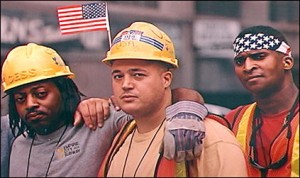 It is inconceivable that we truly believe that the machinist at Boeing, the welder at Ford, the millwright at Alcoa, the pipe-fitter at General Electric or the electrician at Intel has less value or worth than anyone on Wall Street. It isn’t the people on Wall Street doing the real work of this country, but others that produce a tangible product. We didn’t win WWII through the efforts of paper pushers in Manhattan, but the average Joe/Jane out there creating and making the war materials necessary for our survival.
It is inconceivable that we truly believe that the machinist at Boeing, the welder at Ford, the millwright at Alcoa, the pipe-fitter at General Electric or the electrician at Intel has less value or worth than anyone on Wall Street. It isn’t the people on Wall Street doing the real work of this country, but others that produce a tangible product. We didn’t win WWII through the efforts of paper pushers in Manhattan, but the average Joe/Jane out there creating and making the war materials necessary for our survival.
How can it be that there are many people in this country, wealthy and apparently arrogant enough, who believe that they are incapable or unwilling to mow their own lawns, prune their gardens, paint their houses, repair what needs to be fixed, prepare their own meals, clean their homes and for god’s sake take care of their own children. Have we come to the point where we have to employ illegal workers from other countries, for incredibly low wages, to do what all of us should be doing ourselves?
Now there’s an indictment of a culture in serious decline!
THE WEEK editor goes on to add to David Brooks’ op-ed:
Are we still an industrious people? Or have we become too soft to dirty ourselves making and selling things?
THE WEEK September 24, 2010
So, what do we actually do in this country anymore?
Corporate influence peddling and outright propaganda has convinced lawmakers, policy makers and the public that we don’t need the actual makers of useful products, but instead we need to ship (outsource) those jobs overseas to third world countries for substantially lower labor and production costs. If not outsourcing then bring in illegal workers who work for wages no American can live on, creating high unemployment and shoddy goods at cheap prices.
Great for corporations, not so good for the average worker in this country.
All the while we go on adding to our overpopulation woes, importing illegal workers, escalating unemployment in traditional blue-collar sectors of the economy while subsidizing an exploding Underground Economy that fuels illegal activities whose members use more taxpayer services, but pay taxes for none of them. All of this is a “fool’s game” if ever there was one, and we all go along with it!
Undoubtedly we do need a more educated base in this country, for all of the obvious reasons.
But what is wrong with college educated machinists, college educated plumbers, college educated electricians or college educated blue collar workers of all persuasions with all the benefits for society and individuals that accrue from more education? What is wrong with keeping high paying manufacturing jobs in this country? So what if we have to pay a bit more for a purchase if it guarantees everyone a standard of living that is fair and equitable.
Breaking soft or breaking tough?
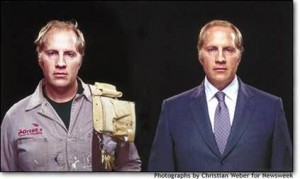 Instead of most of us figuring out the newest application on our smart phones or playing the latest video game on our computers, what is wrong with all of us mowing our own lawns, maintaining our own houses, pruning our gardens, making our own meals, and taking care of our own children? Certainly, if we all chose to do these sometime mundane but necessary tasks we would undoubtedly make our lives simpler with fewer people, and in the end have a stronger, more equitable, fair and just American society.
Instead of most of us figuring out the newest application on our smart phones or playing the latest video game on our computers, what is wrong with all of us mowing our own lawns, maintaining our own houses, pruning our gardens, making our own meals, and taking care of our own children? Certainly, if we all chose to do these sometime mundane but necessary tasks we would undoubtedly make our lives simpler with fewer people, and in the end have a stronger, more equitable, fair and just American society.
Revisiting the reasons for supporting a strong manufacturing base and the hard working dynamic people that are the heart of that system may not end all our many dilemmas in this country, but it would go a long way in mending the soul of our mental and physical toughness that for many has been squandered and lost.
And if we can believe David Brooks, whose analysis in his article also quoted another economist concluding that we would now have a 6.5% unemployment rate rather than the 9.5% if we had not moved our manufacturing sector overseas, certainly that alone is a compelling argument for a resurrected manufacturing sector.
What could possibly be wrong with traveling a proven road? One that certainly has had its share of difficulties and unintended consequences, but in the end could very well return us to a more stable and meaningful economy. An economy that is more independent of foreign influences and entanglements, American based and controlled, and doesn’t add to an already overpopulated citizenry.
Economy, Society
Oct 07
The way in which our social world is constructed is part and parcel of our biological inheritance. Together with apes and monkeys, we’re members of the primate family – and within the primates there is a general relationship between the size of the brain and the size of the social group. We fit in a pattern. There are social circles beyond it and layers within – but there is a natural grouping of 150.
This is the number of people you can have a relationship with involving trust and obligation – there’s some personal history, not just names and faces.
Robin Dunbar The Guardian March 10, 2010

Sebastian Junger in his latest book, War, summarizes the significance of the Dunbar Number:
- Dunbar compared the brains of primates and contemporary humans and and used that ratio to come up with 150
- The neocortex is the part of the brain most relevant to increasing and limiting the number of personal relationships
- Hunter-gatherers lived in informal communities of between 90 to 221 people – Neolithic villages are estimated to be around 150
- Larger numbers are difficult to control with peer pressure alone
- Communities of 150 began to find common benefits in social and defensive relationships that began to form tribes and confederacies
- The idea of “us” and “them” was more pronounced with different languages and cultures evolving
Violence, War, Cruelty, Suffering: The Mark of Mankind
Junger goes on to remind us that our evolutionary past suggests up to 15% of all deaths were in violent confrontations with other groups and tribes. To put that in perspective only 2% died from wars and violence in the twentieth century, but of course the overall numbers in the last century is a magnitude beyond any real comprehension, and certainly dwarfs the 15% throughout prehistory.
Mankind has a great capacity for killing each other and there is absolutely no evidence that it will not continue unabated. Most importantly, we have the means to finally destroy not only ourselves but also the means for the planet to regenerate itself. In other words we have become so brilliant, we can, if we so choose, make this planet a veritable desert with all life forms ceasing to exist.
Now that’s a legacy we can all be proud of!
Overpopulation and The Dunbar Number
What should be most worrisome for all of us if this Dunbar Number can be believed, and there is no real reason not to at least give it some credibility, is that we are evolutionarily wired to resist large numbers of people around us. Suspicion, paranoia and fear seem to be a natural phenomenon and reaction when certain numbers are reached. Consequently, we do feel out of control and unable to maintain a spirit of community and companionship when individual relationships, business connections and social networks begin to approach 150 people and larger.
 That could be a reason for our general uneasiness with the size of governments at the federal, state, cities and local levels. How about corporations and large businesses, hospitals, the military and other organizations that have become so immense and cumbersome that we simply don’t trust them to establish a meaningful relationship with us?
That could be a reason for our general uneasiness with the size of governments at the federal, state, cities and local levels. How about corporations and large businesses, hospitals, the military and other organizations that have become so immense and cumbersome that we simply don’t trust them to establish a meaningful relationship with us?
Instead of us controlling them, they manipulate and control us.
And of course, if we are feeling uncomfortable living and working with 300 million people in this country, what about a world that approaches seven billion! If 150 is the estimated maximum, the neocortex must be in a constant state of agitation and anxiety just trying to comprehend much less assimilate the sheer volume of those numbers.
Technology can deceive us into believing we are in communication with the entire country. We watch television, operate our computers, communicate on our cell phones, read our newspapers and magazines and believe we are in touch with the rest of the country and even the world.
But for all of that, we actually know very little or nothing about the vast majority of people whom we have any contact with through any of the media or communication networks. And deep down we all know viscerally that our lives are an illusion of connection rather than of any substance.
In the end we have very little control of our lives where some live in privilege and good fortune while others suffer lives of poverty and want. It is no accident then that jails, prisons, mental institutions are full of those unable to live in a culture cluttered by too many people competing for declining resources, which are being consumed at an ever increasing rate.
The Dunbar Number may not totally explain the ramifications of the overpopulation quandry we find ourselves. Nevertheless, it certainly gives us a fascinating insight and clue into the human psychic and evolutionary biology. That puzzle and consequent feelings of alienation and confusion may help explain why more is less and many more will most likely lead us to our ultimate downfall.
Society Causes, Dunbar Number
Sep 25

A few miles from the White House in southeast Washington sit some of the worst public schools in America. The students there are mostly poor, mostly black, and their test scores are low. Only one in three finish high school; of those who do go on to college, just five percent graduate.
60 Minutes: How the Seed School Is Changing Lives: May 23, 2010
This is certainly a glaring indictment of the wealthiest county in the world, which in its own capital is unable to successfully graduate the vast majority of students in their public school system. Even more disturbing is that apparently until more recently no one seemed to care. A new high profile Chancellor, after three years of hard work and many changes, has been only marginally successful in restructuring a system everyone agrees is in ongoing terminal crisis.
But right in the middle of this same area is also one of the most successful and innovative public schools in the country. Started in 1998, the school is called SEED. It’s the nation’s first urban public boarding school. Ninety one percent of the students finish high school, and 95 percent go on to college. It’s a charter school that’s getting national attention.
60 Minutes: Seed School
So, right in the middle of one of the worst school districts in the country is one of the best schools in the country. How can that happen? And more importantly, why isn’t it happening all over the country and in every school district?

Admission is by lottery, open to any family in the district willing to take a chance. This last spring, parents and children showed up for a lottery with a unique prize: a $35,000-per year education paid for by private and government money. Only a third of the over 200 or so kids who applied heard their number called. It all starts on SEED’s campus, a four-acre oasis, a safe zone where 340 kids can focus on school, free from distractions back at home.
60 Minutes: Seed School
Some numbers are helpful here. According to a Washington Post series in 2007, which is somewhat dated but still puts much into perspective, the Washington DC School District has 55,000 students, of which they spend somewhere around $13,000 per student, which is the third highest per student in the 100 largest school districts in the country. The total school budget for FY 2009-2010 was $773 million, which included the cost of 11,000 teachers and employees.
Try getting your brain around those costs and demographics! It is a logistic nightmare to imagine this school district even runs at all.
A Few Things Stand Out
-
It takes a boarding school (five nights a week) to get results. In other words home is not a great environment for succeeding in school.
-
That boarding school environment costs $35,000 per year per student, paid by a combination of PRIVATE and government funds.
-
There are only 340 students in this walled-off “safe zone”. What’s going on outside the zone?
-
Only 200 applied for the available openings. What were the other 50,000 children/parents thinking about? It is a lottery.
-
Multiply 55,000 students by $35,000 plus building infrastructures. Any hope of that happening anytime soon so a majority of the remaining students could be included?
Overpopulation and Education: A Grim Scenario
SEED (Schools for Educational Evolution and Development) is the brainchild of Raj Vinnakota and Eric Adler. The two former businessmen quit their jobs 13 years ago to take an old idea and make it new. “There’s boarding schools for rich kids; why aren’t there boarding schools for poor kids?” Vinnakota said. “The intense academic environment, the 24-hour aspect and constant access to role models. Why wouldn’t all of those things be just as important for poor kids as it would be for rich kids?” “We believe very strongly that there is a group of kids for whom the answer is a 24-hour supportive educational environment. And they’re not gonna have a shot if we don’t give it to them,” Adler added.
They (SEED) don’t simply have to raise a kids’ test scores – they have to change their values.
60 Minutes: SEED School
-
An educational environment, ethical values, committed role models and substantial amounts of money make all the difference in the world of public education
-
Where are parents in this formula – they are purposefully excluded because they are the major cause of student failure
-
The Seed School makes up only one-half of one percent of the school children in Washington DC
-
Kudos to SEED. but what are the chances of adopting this throughout the district, not only for college bound students but for the majority of students seeking technical and trade school curriculums
-
So it is plain to see we are chasing the numbers game again, and the chance for catch-up is depressingly bleak
-
In fact it is time for all child-rearing age people to really rethink whether they have what it takes to be a parent
Education, particularly for young minority women, is crucial for both birth rates and hence overpopulation to decline.
If there is any hope for education, total student numbers must be drastically reduced so programs such as SEED and the Andre Agassi Foundation for Education can be more universally adopted.
That would mean significant progress is not only a reality for a few, but a realistic scenario for most.
Society Children, Education
Sep 10
If Newsweek wants to understand why its readership is declining it need only look to Robert Samuelson and his latest ramblings in the Business column for the August 16th issue of the magazine titled, The Parent Trap: How our budget policies hurt families.
His major points:

- Our society does not – despite rhetoric to the contrary – put much value on raising children
- Present budget policies punish parents, who are taxed heavily to support the elderly
- Tax breaks for children are modest
- Americans may choose not to have children or to have fewer children if we have deficit reduction measures
- Fewer children translates to economic decline
- Societies that cannot replace their populations discourage investment and innovation
- They have stagnant or shrinking markets for goods and services
- Some European countries and Japan’s fertility rates are falling to 1.2
- The United States’ fertility rate is at 2.1 and 40% of the births are to unmarried, poor and unstable mothers
- In wealthy societies government now supports the elderly, diminishing the need for children
- Deficit reduction must include spending and benefit cuts for the elderly and higher taxes for everyone except parents
- He quotes another economist, parenting is “one of the most important services any American can perform”
Major points in response:
Does Mr. Samuelson not watch any television, read his own magazine or any of the other major magazines that not only emphasize, but glamorize and glorify every aspect of motherhood. There are entire industries, corporations, associations, marketing minions that do nothing else but mindlessly encourage motherhood and the value of children. Billions are spent. “Not much value”, I don’t think so!
And why shouldn’t parents bear the full responsibility for living in this society. They were raised by parents who are now elderly and need some help, especially when medical science continues to extend their life expectancies beyond their wildest dreams. The elderly haven’t chosen to be old, while parents have chosen to be parents, or at least should have chosen. What do you want to do, throw the elderly out on the street or maybe we can just euthanize those old folks. Now there’s a solution we can all live with!
Modest tax breaks for children? Get real. If you call the personal tax exemption, child tax credit, child-care tax credit ,adoption tax credit and public education modest, just go talk to the people who have no children and make up for all those credits and benefits with their increased taxes and see if they think those tax breaks are so modest. Not to say what it cost to subsidize that 40% or more of the population that have no business having children in the first place.
 Women and couples are choosing to have fewer or no children because they are more educated and smarter. It has nothing to do with higher taxes, deficit reduction or whatever. Any fool can produce a child and many do. Some of the more thoughtful among us are beginning to realize their parenting abilities and skills are limited by circumstance and temperament.
Women and couples are choosing to have fewer or no children because they are more educated and smarter. It has nothing to do with higher taxes, deficit reduction or whatever. Any fool can produce a child and many do. Some of the more thoughtful among us are beginning to realize their parenting abilities and skills are limited by circumstance and temperament.
Now the truth comes out, what children really mean in a consumer economy is another commodity and future purchaser of goods and services. And without a steady increase in that commodity, according to economists such as Mr. Samuelson, we will wander through years of want and suffering. Declining economies decline for many reasons but lower fertility rates is not one of them. Only fools and economists believe that growth economies are infinite.
I don’t understand this concept of declining fertility rates (less people) translating to less economic investment and innovation. What kind of thinking is this? Why wouldn’t people be more confident about entrepreneurship and more creative in their thinking with a society that lives within its means, creates a more educated and dynamic populace, and understands that a successful civilization is not measured in numbers of people but quality of its people.
Shrinking markets for goods and services is a good thing! People are forced to make choices based on real need not whim and fashion. Most Americans don’t need half the things they have already, much less anymore stuff. What we really mean is that we must produce more useless goods and services for jobs creation when we choose to grow populations. Reduce populations and we no longer have that requirement. Seems simple enough to me.
So what! Japan’s women and couples are obviously getting smarter. Why would you choose to have children if you didn’t want any and destine yourself to a life of drudgery and suffering, especially in a small geographically challenged island nation that needs less people not more. Again, the choice is not to produce children because it is your duty as a citizen or a woman, but because you actually want children, and can afford them and make all the sacrifices that come with such a choice. And as for Europeans, they have been through the war and turmoil thing for millenniums and my guess is they are finally understanding the connection between overpopulation and war – which is long overdue. We would do well to emulate them. And besides all that, their quality of life quotient – except for their growing immigrant populations – seems to be much superior to the rest of the world’s.
America’s fertility rate would be much less except for Latino and other ethnic groups that haven’t got the message yet. You don’t need four or five children to take care of you in your old age, and besides most of the new immigrants live in big cities not in rural farming areas. So much for the “help out on the farm” justification. As for the 40% that Samuelson slips in as almost an aside, that speaks volumes to where we are going to end up in this culture if that trend continues. Except for Walmart’s love affair and feeding frenzy relationship with these people, I suspect most Americans would like to see this trend go away in a hurry. That 40% gives new meaning to the words, government supports and subsidies. To all of us taxpayers out there that translates, more money for people we don’t really need and less for people who truly do have needs.
Sorry, but I don’t get this. How does helping the elderly – a necessary and right thing to do in any civilized society – diminish the need for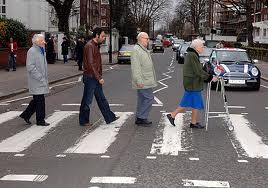 children. First of all we don’t need children, what we need are couples that are capable, diligent and dedicated enough to choose to have children. We can all rest assured that children will never be on the Endangered Species List, at least not until we finally turn this planet into an inhabitable desert by continuing to reproduce quantities of human beings that we DON’T need! Mr Samuelson we can continue to help those elderly that need it and continue to have children, we just have to make economic choices and sacrifices that foster care and nurturing for both groups. By the way I guess it didn’t occur to you that by emphasizing quality children over quantity, we will reduce future elderly populations – exactly the group you seem to feel takes up way too much room and resources in this society.
children. First of all we don’t need children, what we need are couples that are capable, diligent and dedicated enough to choose to have children. We can all rest assured that children will never be on the Endangered Species List, at least not until we finally turn this planet into an inhabitable desert by continuing to reproduce quantities of human beings that we DON’T need! Mr Samuelson we can continue to help those elderly that need it and continue to have children, we just have to make economic choices and sacrifices that foster care and nurturing for both groups. By the way I guess it didn’t occur to you that by emphasizing quality children over quantity, we will reduce future elderly populations – exactly the group you seem to feel takes up way too much room and resources in this society.
First, read the last paragraph again! We are all in this together, like it or not. Reducing budget deficits should mean equal sacrifices for all groups. If that means people choose to have fewer children so be it, that’s all part of it. But I guess for you that means this generation that created this nasty, selfish economic crisis we find ourselves, should now place the burden of the debt we have created on the backs of increasing numbers of future generations so you can be assured of collecting your Social Security and Medicare checks. Wow, I get it now!
“One of the most important services an American can perform”? Does that not seem eerily close to the German Nazi propaganda machine of WWII? Having children is now our patriotic duty, a “service” to “perform”. Whether cannon fodder for the “fatherland” or a commodity to fuel a declining economy, we now know what the real value of children has become. Why don’t we just line up all those unpatriotic, self-centered women and AI all of them. What could be more important than the American economy? Instead of a “chicken in every pot” we could have “five kids in each home”.
Now that would surely take care of all our economic problems.
Economy, Society Children, Elderly, Growth Economy
Jul 25
Massively tragic overpopulation will not redeem, liberate or dignify anyone. Rather, it will imprison the human spirit, heighten economic inequality and kindle unending strife and despair.
William Hollingsworth, Ending the Explosion 1996
This book dares to go beyond the conventional wisdom. It comes to grips with the need for solutions that are both adequate and humane. In doing that, and in doing it so well, this book meets a dire need in the population policy discussion. Professor Hollingsworth shows in poignantly human terms why humanity must promptly redirect its reckless demographic course.
Donald Mann, President, Negative Population Growth, Inc.
Afterword: A Comparison
- The population of the United States today is 309 million people
- In 1996 we had a population of 265 million people
- That is a 14% increase in about 14 years or 44 million people
- Some perspective: that is another state of California plus 7 million people
Today, we surely are more and more imprisoning the human spirit, heightening economic inequality and kindling unending strife and despair.
Two Questions
- Consider what it is going to be like with at least 353 million people in 2024
- Would this country not be far better off today with 44 million fewer people
Society Statistics
Jul 23
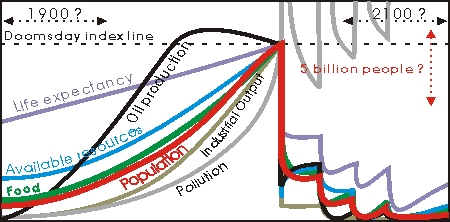
A Perfect Catastrophe
The graphic was created by me in an effort to try and project a reasonable growth pattern for these various important factors impacting humanity. The dates are not exact because the effects are not exact but over the course of a hundred years they will probably look reasonable. More reasonable than other projections I have seen because no one seems to fess up the the likelihood of a major war and what that will look like when graphed.
PROBAWAY-LIFE HACKS

In the early years of the 21st century, the United States continues on a course toward adding another 100 million people by 2035. (Source: “US Population Projections” by Fogel/Martin, PEW Report, U.S. Census Bureau) Beyond that, population projections show America doubling its current populace to 600 million in the latter half of this century. At the same time, the world demographic figures show an added three billion humans to planet Earth by 2050.
With accelerating ‘symptoms’ exploding across America and the world via water and food shortages, species extinction rates, energy crises, climate destabilization, ocean dead zones and more ramifications on multiple levels—we find ourselves passengers within a civilization that parallels the metaphor of the Titanic. If you remember, on April 14, 1912, the RMS Titanic, the finest steamship of its era, on its maiden voyage, sped too fast and arrogantly through iceberg infested waters of the North Atlantic. It hit one and sank—to become one of the greatest tragedies that didn’t have to happen in the 20th century.
Our own grave overpopulation crisis need not manifest within the United States, either, if we change course. Like Captain Edward John Smith of the Titanic, he could have slowed down or steamed further south to avoid his fate.
The United States could also change course and avoid adding 100 million people within the next 25 years. However, no American leaders step up to the microphone with any concern. The passengers of our American civilization continue ‘trusting’ their leaders similarly to the passengers on the Titanic. “Captain Smith knows what he is doing,” they said. “Our U.S. Congress and president must know what they are doing,” citizens lament.
But like Titanic’s Captain Smith, the U.S. Congress and president of the United States—don’t know what they are doing.
Frosty Wooldridge
We put that question ( Why Is Population Control Such a Radioactive Topic? ) to several experts from diverse perspectives, including a feminist, a science writer, an obstetrician, a racial justice advocate, and the author of The Population Bomb.
They checked in on this Mother Jones forum May 12-14 to discuss their controversial answers with readers—and each other. Want to hear more from Paul Ehrlich, Fred Pearce, Julia Whitty, and the rest of our panel about their take on population control? Now’s your chance.
Mother Jones
Guest Author The Titanic
Jul 18
At first look it would seem there could be no more two incongruous films than Battlestar Galactica and Groundhog Day!
One, A Melodramatic Look Into the Future and Past
A lost, nuked human race, pursued by their own man-made attackers rockets away from the vestiges of their doomed planet, all the while searching endlessly for a new home in the not too friendly outreaches of intergalactic space.
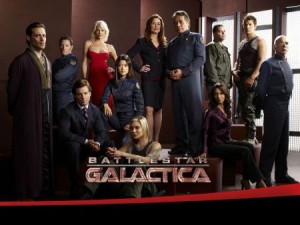
The Cylon War is long over, yet we must not forget the reasons why so many sacrificed so much in the cause of freedom. The cost of wearing the uniform can be high, but… sometimes it’s too high. You know, when we fought the Cylons, we did it to save ourselves from extinction. But we never answered the question “Why?” Why are we as a people worth saving? We still commit murder because of greed and spite, jealousy, and we still visit all of our sins upon our children. We refuse to accept the responsibility for anything that we’ve done, like we did with the Cylons. We decided to play God, create life. And when that life turned against us, we comforted ourselves in the knowledge that it really wasn’t our fault, not really. You cannot play God then wash your hands of the things that you’ve created. Sooner or later, the day comes when you can’t hide from the things that you’ve done anymore.
Commander William Adama Battlestar Galactica
The Other, A Comedy of Sorts
A silly Pennsylvania tradition is frozen in time while a weatherman plays out his existence, returning to the same day after day monotony, until he recognizes, understands and transforms his many character flaws, and his life no longer remains on hold.
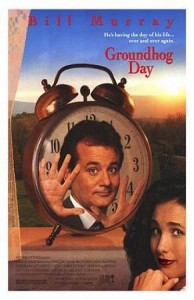
Phil: What if there were no tomorrow?
Gus: No tomorrow? That would mean there would be no consequences, there would be no hangovers. We could do whatever we wanted!
Phil: [thinking] That’s true. We could do…whatever we wanted.
Phil: Well, what if there is no tomorrow? There wasn’t one today.
Groundhog Day
Lessons and Consequences of Choices
Today, the films combine to reveal abject lessons as our planet struggles badly with its own future:
- We are constantly driven by huge ever increasing populations
- Completely dependent on technology for our survival
- The unmitigated failure to learn from the mistakes of the past
- Blinded by the misery that surrounds us
- Too trapped by fear and the unkown to change our ways
- And the chances for survival precariously slip away as each day passes
There is a ruthless naivete and irony by the remaining fifty thousand survivors of the Galactic ship’s crew and supporting flotilla:
- They curse and blame the dogged enemy
- They justify and defend themselves against the onslaught of Cylon robots and human hybrids
- Those Cylons were created to ply the work that the human race decided was either beneath or beyond them
Like the computer HAL in 2001-A Space Odyssey, which was designed to support wider human exploration, and then transcends that purpose to control and dictate to its creators much more than was ever imagined.
Once we finally give our destiny and our very existence to technology alone, the soul and spirit of mankind dwindles into a meaningless darkness, the same darkness from which we have most likely emerged so many times before, either here on this planet or other places in the universe.
Redux Again
Whether one fictional character is entrenched in a 24 hour cycle or it is a race of humans mucking away in another one million year cycle, it is the same mendacity and sense of superiority that prevails and guarantees our downfall.
So there is a collision of minds between Battlestar and Groundhog. Together, in a most unlikely tandem, they warn us again that as our numbers increase and we are compelled to turn to technology for our very survival, we must also face the consequences of that pact.
Therefore, when the machines of technology once again destroy, replace or drive us from this venerable and endangered environment, and those who survive begin their quest for yet another sanctuary, there is nothing left to blame but ourselves.
Society, Technology Battlestar Galactica, Groundhog Day
Jul 06

Ours is a world of nuclear giants and ethical infants. If we continue to develop our technology without wisdom or prudence, our servant may prove to be our executioner.
General Omar Nelson Bradley
The Struggle of Biological Man and Technological Man
Biological mankind, in a relatively stable environment for over a million years, is finding the contemporary pace of emerging technologies a test for everything that we have known before.
- All of mankind’s biological history has little to do with present digital information based lifestyles
- Fifty years is a genetic and instinctual minute compared to the previous million years
- It will be many centuries before our primordial nature fully adapts to the realities of ever-changing technology economies
So we are not simply 21st century beings, but a complex compilation of thousands of centuries, blended into behaviors we all exhibit today.
Consequently, the pace of our technology transformation is out of sync with mankind’s traditional capabilities.
The Results of Consumer Technology and Expanding Populations
- Violence: A national symbol of American culture
- Crime Rates: An urban nightmare
- Prisons: If not for cost we couldn’t build them fast enough
- Mental Hospitals: Crowded warehouses for discarded lives
- Fear-Anger-Neurosis-Anxiety-Depression-Virtual Reality: You name it, we got it
- Detached-Solitary-Impersonal Lives: Hiding behind Televisions, Computers, Smart Phones
- Children Having Children: The only thing they know
We are out of balance, out of touch with the classical relationship we have had with our environment, and therefore, with each other.
We know technology can have many benefits, but there is a growing awareness that the benefits, if left unchecked, may control our lives in ways we are not fully able to comprehend yet.
The Old Triangle
Life forms on earth emerged because three separate elements of the environment (air, land, and water) produced conditions which were necessary for sustaining and developing new life systems.
Man is a product of adapting to the natural world, which shaped both his physical characteristics and his emotional and intellectual development.
For eons, an ancient triangle existed which represented man’s dependent relationship on the three basic elements. It was man’s precarious link to existence, a link which controlled his life and dictated his daily routine.
The New Triangle
The points on the old triangle, are being involuntarily reshuffled into one unified point. The other two points have now been replaced by powerful forces which are incrementally changing traditional biological relationships of the distant past.
- The Environment
- Mankind
- Technology
The environment then is no longer the singular engine of this planet, but part of a troika pulling the train of life.
It is a serpentine trail wandering through time in a perpetual state of change, unsure of its destination, but moving steadily away from the roots of mankind’s existence.
Some believe technology is the new savior, a priceless discovery to be nurtured and developed until it finally reveals all its great secrets, and we will finally be free from the environment’s primordial, dependent relationship.
Technology is predicted to be the great liberator of human toil and misery, a super-renaissance in the ongoing development of our existence on this planet and beyond.
Remembering the Past: Fight or Flee Instincts
From past history, combined with the lessons of more recent events, it is questionable whether mankind is prepared for the journey.
If we are both lucky and smart we will continue our march through time.
Surely we can alter and control the acceleration and ultimate velocity of our travels, and it may be prudent and timely to do so.
Without fully considering all the possible ramifications, the journey for many in the past has been and could be for most of us in the future one of ongoing terror and violent conflicts.
We still remain more biologically suited to searching for food with fight or flee instincts, rather than pondering and adapting to technological and population forces racing to new levels beyond our wildest dreams.
Image Credit: Technology and Evolution www.encefalus.com
Society, Technology Triangle of Life
Older Entries Newer Entries


 It is inconceivable that we truly believe that the machinist at Boeing, the welder at Ford, the millwright at Alcoa, the pipe-fitter at General Electric or the electrician at Intel has less value or worth than anyone on Wall Street. It isn’t the people on Wall Street doing the real work of this country, but others that produce a tangible product. We didn’t win WWII through the efforts of paper pushers in Manhattan, but the average Joe/Jane out there creating and making the war materials necessary for our survival.
It is inconceivable that we truly believe that the machinist at Boeing, the welder at Ford, the millwright at Alcoa, the pipe-fitter at General Electric or the electrician at Intel has less value or worth than anyone on Wall Street. It isn’t the people on Wall Street doing the real work of this country, but others that produce a tangible product. We didn’t win WWII through the efforts of paper pushers in Manhattan, but the average Joe/Jane out there creating and making the war materials necessary for our survival. Instead of most of us figuring out the newest application on our smart phones or playing the latest video game on our computers, what is wrong with all of us mowing our own lawns, maintaining our own houses, pruning our gardens, making our own meals, and taking care of our own children? Certainly, if we all chose to do these sometime mundane but necessary tasks we would undoubtedly make our lives simpler with fewer people, and in the end have a stronger, more equitable, fair and just American society.
Instead of most of us figuring out the newest application on our smart phones or playing the latest video game on our computers, what is wrong with all of us mowing our own lawns, maintaining our own houses, pruning our gardens, making our own meals, and taking care of our own children? Certainly, if we all chose to do these sometime mundane but necessary tasks we would undoubtedly make our lives simpler with fewer people, and in the end have a stronger, more equitable, fair and just American society. 
 That could be a reason for our general uneasiness with the size of governments at the federal, state, cities and local levels. How about corporations and large businesses, hospitals, the military and other organizations that have become so immense and cumbersome that we simply don’t trust them to establish a meaningful relationship with us?
That could be a reason for our general uneasiness with the size of governments at the federal, state, cities and local levels. How about corporations and large businesses, hospitals, the military and other organizations that have become so immense and cumbersome that we simply don’t trust them to establish a meaningful relationship with us? 


 Women and couples are choosing to have fewer or no children because they are more educated and smarter. It has nothing to do with higher taxes, deficit reduction or whatever. Any fool can produce a child and many do. Some of the more thoughtful among us are beginning to realize their parenting abilities and skills are limited by circumstance and temperament.
Women and couples are choosing to have fewer or no children because they are more educated and smarter. It has nothing to do with higher taxes, deficit reduction or whatever. Any fool can produce a child and many do. Some of the more thoughtful among us are beginning to realize their parenting abilities and skills are limited by circumstance and temperament.  children. First of all we don’t need children, what we need are couples that are capable, diligent and dedicated enough to choose to have children. We can all rest assured that children will never be on the Endangered Species List, at least not until we finally turn this planet into an inhabitable desert by continuing to reproduce quantities of human beings that we DON’T need! Mr Samuelson we can continue to help those elderly that need it and continue to have children, we just have to make economic choices and sacrifices that foster care and nurturing for both groups. By the way I guess it didn’t occur to you that by emphasizing quality children over quantity, we will reduce future elderly populations – exactly the group you seem to feel takes up way too much room and resources in this society.
children. First of all we don’t need children, what we need are couples that are capable, diligent and dedicated enough to choose to have children. We can all rest assured that children will never be on the Endangered Species List, at least not until we finally turn this planet into an inhabitable desert by continuing to reproduce quantities of human beings that we DON’T need! Mr Samuelson we can continue to help those elderly that need it and continue to have children, we just have to make economic choices and sacrifices that foster care and nurturing for both groups. By the way I guess it didn’t occur to you that by emphasizing quality children over quantity, we will reduce future elderly populations – exactly the group you seem to feel takes up way too much room and resources in this society. 




